
We asked our team to choose their three cultural highlights of the year, along with a favourite event and/or organisation. Enjoy reading their individual responses below.
Young Critic, Gareth Williams
Junkyard: A New Musical (Theatr Clwyd, Mold) Real, raw, inventive, inspiring; provoking and entertaining social commentary; one of the most original pieces of theatre I think I’ve come across this year, with an exceptional cast, script, and set design.
Alice in Wonderland (Storyhouse, Chester)
A truly charming and inventive take on this well-known tale; a talented cast who brought the characters of Lewis Carroll’s beloved children’s classic to life in vivid detail; perfect family viewing; the standout show of Storyhouse’s opening season.
Broken (BBC Drama Series)
Sean Bean was excellent as the passionate yet broken priest trying to make a difference in a Northern working-class community; as always from writer Jimmy McGovern, a piece which dealt with contemporary social issues in an engaging, challenging and no-nonsense way; a beautiful portrait of contemporary Christian faith.
The opening of Storyhouse in Chester
A wonderful addition to the North Wales/North West England arts scene. A stunning building with a beautiful theatre, modern cinema, integrated library, and plenty of communal spaces. An arts space that is truly for the community, that is already making a positive impact on the city and its people through various projects, shows and initiatives.
Community Critic Kevin Johnson
Hamlet. Andrew Scott gave what I can only described as an Irish Hamlet, sad, bittersweet and quietly morose. He sees the humour through the madness and the sorrow, yet his heartbreak was always just behind his eyes. Like some romantic hero of legend, dark and brooding, he used this masterfully to make us care for the Dane all the more.
The setting was modern, innovative and intriguing. The play began with coverage of the funeral straight from a Danish cable news channel. The play within the play took centre stage, the cast sitting in the front row among us, their faces thrown by video onto screens around the auditorium. A clever use of old and new. They wore tuxedos as if at the opera, and were covered by cameras as such.
In other modern twists Polonius had dementia, Rosencranz and Guilderstern were a couple, and both Hamlet and his mother spoke with Irish accents, unlike Claudius. A superb and thoughtful production that gave me new insight into the play.
My second choice is Angels In America, the first London revival since the original in 1992. With Andrew Garfield taking the lead of Prior Walter, this was a huge play, both in ambition, talent and scope. Performed in two parts, it’s just over eight hours in total, but amazingly the time went by so fast.
Garfield won the Evening Standard Award for Best Actor but Nathan Lane is equally as good as the venal Roy Cohn, hurling racist insults from his sick bed at his nurse, and threatening his doctors with lawsuits, it was still hard not to be moved as he fought for his life using every dirty trick in the book.
Although I thought it slightly bloated, and perhaps too self-indulgent in places, the sheer audacity of the play steamrollers over such quibbles. This was a tour de force if ever there was one.
My third production is The Cherry Orchard, a homegrown reworking of Chekhov set in Pembroke in 1982. It made me so proud to see such a great play from a Welsh company, easily the equal of anything I’ve seen in the West End.
I’ve been a fan of writer Gary Owen since seeing Iphigenia In Splott, and Killology, also Sherman Theatre productions, and this was the ‘cherry’ on the cake, pun intended! The whole cast contributed to making it truly memorable, with Mathew Bulgo in particular creating a nuanced performance that defied good or bad and was just human.
Unsurprisingly then, my favourite company and venue of the year was the Sherman Theatre. As a theatregoer, I’ve been welcomed by every member of staff, it’s foyer is roomy and full of comfy chairs and sofas, and they continually produce work of the highest order, on both the small theatre and the large. Outstanding.
My cultural highlight of the year is a little unusual, given so many wonderful choices, but I’ve chosen Slava’s Snow Show. Premiering in 1992, it has toured all over the world, usually at Christmas. I’ve missed seeing it so many times, so when it played the Millennium Centre I was determined to catch it. And catch it I did.
Simply put, I was enchanted. When I tell you that I don’t like clowns, and that the entire cast are dressed as sad, world-weary clowns, you can see what an achievement this was!
There was no dialogue as such, no plot, and I can’t even begin to describe what went on, yet it evoked such joy and wonder in me that I remembered what it was like to be a child again. Suitable for ages 3-90, I’ve never seen anything that unites all the generations this way.
Created by Slava Polunin, a Russian clown and mime, its won several awards around the world, including the Drama Desk Award for Unique Theatrical Experience. I think that sums it up nicely.
Young Critic, Sebastian Calver
Oslo, National Theatre
The Grinning Man, Bristol Old Vic
Heinsberg, The Uncertainty Principle
3rd Act Critic, Helen Joy
This is difficult as this year, I was very selective and so was privileged to experience some truly brilliant performances. With one exception. My top top event, was the Hot Tub extravaganza and in part because of my involvement and also because it was so outside my ken. Talking about our engagement with the arts here in Wales and as inconvenient wimmin of a certain age, was most refreshing!
Shadow Aspect, Ballet Cymru. Casting light into dark places.
Le Vin Herbe. WNO Perfect. Simply perfect.
My venue of 2017 would have to be Blackwood Miners Institute. Welcoming, warm, good facilities, parking and a very personable attitude.
My Company of 2017 is Black Rat Productions. For making us laugh. Never underestimate the power of a well produced comedy. One Man Two Guvnors. Good hearty stuff!
Community Critic, Steph Back
You’ve Got Dragons, Taking Flight.
Slava’s Snow Show
Fear, Mr and Mrs Clark.
Young Critic, James Briggs
La Cage Aux Folles, New Theatre Cardiff. Such an emotive and fun musical in which the story is still very prominent today.
Anton and Erin Swing Time– A much needed touch of class from years gone by. Celebrating the best of dance and ballroom.
A Judgement in Stone– A classic murder mystery that left the audience on the edge of their seats. An amateur sleuths idea of heaven.
My Cultural event of 2017. Celebrating the New Year in London watching Cinderella the Pantomime at the London Palladium and watching the fireworks from along the river bank.
My company of 2017 is Cinderella at the London Palladium. A stellar cast that really did bring everything to the pantomime. With names including Paul O’Grady, Julian Clary, Lee Mead and many more it was ‘the’ theatre experience of 2017.
3rd Act Critic, Ann Davies
Swarm, Fio Productions
Rhondda Road, Avant Cymru and RCT Theatres
Art in the Attic
I would like to highlight the work of Rachel Pedley and Avant Cymru during 2017.
A venue of great importance to me during 2017 has been The Factory, Jenkin Street, Porth RCT.
Community Critic, Hannah Goslin
Running Wild, Theatre Royal Plymouth
The production took a book from the well known writer Michael Morpurgo (of War Horse fame) and just like War Horse, transformed the stage with great creativity to take us to different places, and make us believe that the animals were real on stage with intricate puppetry.
Flossy and Boo: The Alternativity, The Other Room, Cardiff
This show brings a different taste to the usual Christmas shows full of kids entertainment and religious entail. Flossy and Boo create and exciting, fun and fully adult show to get you in the Christmas spirit but laugh at it satirically. Full of unusual concepts, music and lots of comedy, The Alternativity really gets you in the mood for Christmas.
Fourteen Days, BalletBoyz, Exeter Northcott
An arrangement of dance pieces, all with different concepts, BalletBoyz manage to astound yet again with their seamless movement, great acting and wonderful stamina. Balletboyz seem to only get better and better.
My Company of 2017 must be BalletBoyz. They are just incredible!
3rd Act Critic, Roger Barrington
The Wind in the Willows, Sherman Theatre. Great fun, highly creative with a very talented production team.
The Cherry Orchard, Sherman Theatre.
Little Wolf, Lucid.
The best exhibition I have seen this year is : Swaps – David Hurn – An outstanding and important exhibition at the National Museum Wales .
Young Critic, Sian Thomas
Cardiff Fringe Theatre Festival, particularly the event in mid July (but all the events were stunning) where I read some of my own work. I met great people and had a wonderful time and it has definitely shaped my year. I’ve become more confident with sharing my own work and have enjoyed events later into the night too, which isn’t something I did enjoy before this festival.
Layton’s Mystery Journey. Even though I didn’t enjoy the game I think playing it and experiencing a franchise I’ve loved in the past in the present was important for me. It made me realise that things don’t always survive my rosé-tinted glasses of nostalgia, and upon taking them off I’ve grown a little as a person. I know my interests much better, I know what upsets me in media much better, and I know my inner circle of friends much better, based on how we all reacted. Sometime positive can come from something initially negative, and I’m glad something has.
Iain Thomas’ “300 Things I Hope”, something I read very early on in the year and something that has been the brightest spot of almost literal sunshine on my bookshelf ever since! It’s a book I’ve traded with friends so we can see which ones stick out to us, it’s a book that spurred me on in my own below-the-radar poetry endeavours, the book that hundreds of sticky notes stick out off, and it’s the book that I like to pull down every so often and flip to a page and remember exactly why I love it.
My company of 2017 would again be Cardiff Fringe. Discovered it this summer and have been attending the monthly fringe cafes in The Gate ever since! It’s been a great time and one I hope to carry on attending. I look forward to see where it goes in 2018!
My personal cultural highlight would probably be the day I finished the first draft of my book – August 12th, 2017! I’m making progress on my goals! I’m on a second draft right now, and could not be more thankful for this year. I’ve had a really great one!
Community Critic, Gemma Treharne Foose
Swarm, Fio Productions
The Mountaintop, Fio Productions
Sunny Afternoon, Wales Millennium Centre
The best company for me in 2017 is Fio for pushing the boundaries of theatre and creating thoughtful and impactful pieced by working with community groups. They also incorporate hard to reach voices in to their work.
The best venue for me in 2017 is Sherman Theatre for the work they do in supporting new voices in theatre, and the efforts they go to in order to make theatre an inclusive, accessible experience.
But I suppose two of my biggest personal highlights this year were finally getting to see the American Folk/Indie group Bon Iver. I’ve followed them for many years and never been able to get tickets for as they typically sell out instantly and cause websites to crash, etc. I once even considered flying to Hong Kong to see them on their Asian tour before realising that was a bonkers idea. My husband surprised me twice this year with tickets to see Bon Iver headline the Forbidden Fruit Festival in Dublin in June, then again in September at Blackpool Winter Gardens. My husband isn’t the biggest Justin Vernon/Bon Iver fan but it meant the absolute world to me. Through the concerts, I was also introduced to the work of Lisa Hannigan and The Staves, which I’ve really enjoyed since the Dublin concert. I wouldn’t say I am massively up to date, experimental or fashionable when it comes to music – I like what I like, but despite the horrendous rain and mud, these two concerts were so meaningful for me. I’ve promised my husband I won’t make him sit through any more whiny Justin Vernon music in 2018. But this of course now means I will be dragged to some kind of weird Cajun/Zydeko/Blues music fest. There’s always a trade-off!
Young Critic, Vicky Lord
Woman in Black. New Theatre, Cardiff. It was something truly different. Obviously it was still scary to the point of terrifying but there were just so many layers of meaning that were left unsaid so that the audience could figure them out it was just truly flawless.
Blood Brothers, New Theatre, Cardiff
Miss Saigon, Wales Millennium Centre
My favourite cultural moment was seeing Lenny’s disability named as Dyspraxia in the August 012, Chapter Arts Centre production of ‘Of Mice and Men.’
Best Organisation, Wales Millennium Centre. It provides a gorgeous temporary home for West End hits allowing people who can’t travel to London the chance to see them.
Community Critic, Emily Garside
La Cage Aux Folles, New Theatre
Rent, WMC
Where Do Little Birds Go, Cardiff Fringe
My company of 2017 is Taking Flight, particularly for their work with young people.
Young Critic Corrine Cox
The Cherry Orchard, Sherman Theatre
Sunny Afternoon, Wales Millennium Centre
In terms of inspirational organisations in 2017, I’d pick National Museum Wales for being genuinely collaborative and inclusive. I have loved their 2017 programming (especially Artes Mundi, Gillian Aires, Agatha Christie photos and Who Decides?) I am also following the exciting developments and vision for St Fagans.
Artes Mundi was personal cultural event of 2017. I found Lamia Joreige’s Beirut piece really interesting and loved Bedwyr Williams’ Big Cities – I think I went back to see the exhibition four times I enjoyed it so much!
Community Critic, Barbara Hughes Moore
The Cherry Orchard, Sherman Theatre. This was not only a pitch-perfect translation of the source material, but a highly relatable, funny and melancholy family drama.
Rip it Up, St Davids Hall. A sublime show, what it lacked in narrative it made up for in energy, fun, and spectacular dancing.
Burning Lantern, St Fagan’s. Despite Queue-Gate, the musical acts were stunning, sublime, and sung their hearts out.
I’d have to nominate Sherman Theatre for my venue of 2017. We on the Law and Literature module at Cardiff have been linked up with Sherman Theatre since 2016, and they have been nothing but supportive, encouraging and welcoming – we have even built in their plays, performances and most recently a post show discussion panel into our module – and I was honoured to be on the post show discussion panel for The Cherry Orchard. They have also kindly come in to speak to our students at lectures – most recently Tim Howe, Communities and Engagement coordinator, led a very successful session on Law, Theatre and Performance, and our Law and Lit students were highly interested and engaged.
My favourite cultural event of the year was Pride 2017/ Return of the Big Weekend. It was my first Pride and it was utterly joyous, especially (or perhaps deliberately & defiantly in spite of) all the dreadful things that happened earlier in the year & the year before. It was beautifully, joyously defiant.
Young Critic, Eloise Stingemore
Funny Girl, Wales Millennium Centre. Sheridan Smith was outstanding, any misconceptions I had about her being the right person for the role where blown out of the water the minute she belted out the first song of the show.
Grease, Wales Millennium Centre. A show that I never wanted to end, a truly spectacular musical in every sense of the word, I want to hand jive baby for days after.
Dinosaur Babies, National Museum of Wales. A truly amazing exhibition for all ages and is worthy of going on tour all across the country with ‘made in wales’ (and with a little bit of help from America) being proudly stamped on it.
My personal cultural of event 2017 was the way the whole of Wales not just the Capital got behind our boys in wishing and dreaming them in qualifying for the World Cup. It seemed that the papers and even just people on the streets whether the be commuting to and from work or having a drink in the pub where talking about it and with so much pride that it made my proud to be Welsh.
Community Critic, Patrick Downes
The Addams Family Musical at Wales Millennium Centre
For a musical to have such an effect on me after hearing the songs for one time, it’s something a little special Creep, cooky, and altogether brilliant all round performance
Harry Potter and the Cursed Child Part 1 & 2 – Much anticipated, did not let me down!
Coldplay at Principality Stadium – Fourth time seeing the band, first time on home soil – Just stunning, even thinking about the night sends goosebumps up my arm
Cultural event; Tiger Bay The Musical, Wales Millennium Centre
Best Venue – Wales Millennium Centre – With a mix of populist, and culture for all ages.
Category Archives: Film & TV
Review Blade Of The Immortal by Jonathan Evans
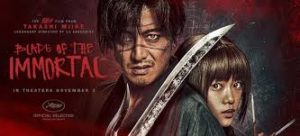
 (4 / 5)
(4 / 5)
Blade of the Immortal is so stylised in it’s over-the-top gory nature that it will definitely turn some people off. However it also knows so whole-heartily what it is that it’s almost inevitable that it shall gain a great following in the future. It is a classic revenge story with a samurai setting and goes extremely colourful and off the wall with it’s execution.
We open in feudal Japan and in Black & White where a swordsman, Manji (Takuya Kimura) is hacking down others. He is with his sister who is disjointed from the situation, it then comes to a fight with probably fifty bandits, they kill his sister and he proceeds to hack them all to pieces, getting a face-scar that also takes his right eye. He lays there dying but a woman in white appears over him saying he cannot simply die like this after killing so many. She drops a Bloodworm into his heart which regenerates his body and making him immortal. Now the movie transforms to colour.
Then cut to fifty years later where a sword-fighting school is teaching it’s students in the art. One particularly eager student is young Rin (Hana Sugisaki), who’s eager to learn the ways of the warrior but uninterested in being ladylike. One night men come to their school saying that they are uniting the country in their teachings of fighting and removing all the others. The leader kills her parents but leaves her alive, after an old woman in white tells her of an immortal swordsman that can help her take revenge.
Manji is like Toshiro Mifune reincarnated. He walks with attitude and with a low gravelly voice. Because of the scar (which inexplicably does not heal), he channels all his emotions and intensity through his left eye with great skill. Rin is one of those cute, young but spirited young female characters that are thrown into a much more brutal world than they are used to but hold strong. Their quest introduced then to many other fighters, all with a different visual style, backstory and physical challenge.
It seems that in all narrative about immortality that it is either bestowed upon people that long for death or denied to those that seek it. Here is a man that lost everything but still lives and doesn’t want to get involved in another conflict. It must also be asked that if Manji is immortal then what are the stakes when he fights? Well he’s not impervious to pain, so there’s that. But also it’s not just about him but Rin, so that also helps.
This is the one hundredth movie by director Takashi Miike. Most directors work at a rate of a movie every two or three years. Woody Allen remains at a rate of one movie a year. Mike works at a rate of five to eight movies a year. They all range from genre pieces, the the mainstream to experimental works. The man loves and is dedicated to his craft more than any other working director.
The style of the movie is contrasted with extreme angels and movements with more carefully composited shots that remain static and let the characters speak. These slower moments are very welcomed. To have extreme angles and a fast moving camera can be visually gripping, but if it was all that there would never be any moments for the audience to breathe (which is essential!). This allows for a digestible passé where action commences, then we absorb it, then another fight happens knowing everything that just happened and the consequences.
This movie is for the people that like Tarantino and Kurosawa and anime in general. Ones that don’t necessarily need original story-lines or a quite passé. This movie starts out with a brutal action scene, if you are already hooked then it is the movie for you, if not then it wont win you over.
Review Star Wars Episode VIII, The Last Jedi by Jonathan Evans

 (5 / 5)
(5 / 5)
When they finally decided to make another Star Wars movie with The Force Awakens it broke the perception of movie goers. They would take what is considered by the fans to be sacred text and push the story and characters forward. What happened with that movie was that everyone had to think about what Star Wars was and if such a thing can be replicated.
The movie does a good job in picking up where the last movie left off, we get our traditional scrolling text that fills in the spaces and then it drops us right into the action. Where the rebel forces are fighting the controlling First Order. They are on their last leg, being relentless chased. This scene is filled with explosions, swooping shots, banter, suspense, the whole package. After it the Rebels are left in a state where they can now be tracked and now must keep at a passe of flying away from the First Orders ships with their shields up, all while their fuel is being depleted.
While this is happening Rey (Daisey Ridley) is on a baron planet where she seeks to recruit the legendary Luke Skywalker, maybe even get some training in while she’s there. Except Luke is all but interested in getting involved in another galactic battle.
Luke Skywalker is just about as iconic as a character can get. Here Mark Hamill returns to the character that launched his career. He appropriately ages him, being more disgruntled and sage-like but he is still the smart mouthed individual thinker he’s always been. I cannot tell you anything about what they do with the character, but it is very bold, very brilliant and Hamill plays all of it so well.
Meanwhile Finn (John Boyega) is being accompanied with new ally Rose (Kelly Marie Tran) to seek out a hacker in a gambling planet. Po (Oscar Isaac) is left frustrated on the ships as the First Order slowly wears them down to nothing.
Also adding to the mix is the tension building up in Kylo Ren (Adam Driver), he killed his father but it has left him shattered as a man. The dark lord Snoke (Andy Serkis) is preparing to snuff out all to oppose him.
I don’t know if it was just me or there’s genuinely something here but I noticed quite a few insertions of quips from the characters. Being that Disney owns MARVEL and their live action movies are also known for making quips I cant help but feel there’s some script doctoring or executive notes given that this must be. They’re fine and certainly aren’t hard to sit through, but it does make me wonder.
Many people noted, and were right, that the last movies plot was identical to the original. During the anticipation they were theorising that this one would be just like The Empire Strikes back. Well it is and it isn’t, let me explain. This is the squeal where the bad-guys hit back hard and the good guys are on the ropes for most of it and just get out by the end, but that’s just a form of storytelling. The heroes have won and in order to make their overall victory seem even greater and make us invested they need to loose some and the opposition needs to win so they remain a viable threat.
Like with the last movie again they incorporate a variety of practical effects and C.G.I. they go as far as they can with making real sets and having people and creatures out of real things, when that ends they make it in a computer. This is good, practical effects will always be welcomed because when there’s something really inform of the camera it will always feel more real and digital is capable of showing things impossible to be made. We need both of them.
This is a gorgeous movie that is probably the best looking Star Wars movie ever made. There are beautifully framed shots that very from classic science fiction world we all know, ancient, mythical environments that are haunting, others which are are sleek and minimal using only one color for the setting. There are moments where the lighting is has a beautiful Rembrandt quality to it in the way it’s cast over the characters faces and is so golden.
This movie, beyond being well crafted and shot reminded me (even more than the last movie) of what Star Wars is. Is is the old stories of good and evil, simple archetype characters that are well defined, it has technology that is beyond us now but is also ancient. The movie deepens the mythology as well as pushes the story and characters forward and delivers on what Star Wars is while doing so. And Star Wars is, if nothing else, entertaining.
Review Wonder By Jonathan Evans

 (4 / 5)
(4 / 5)
Wouldn’t life be better if we were all nice to each-other? If we weren’t so shallow and judged people on who they are and not judge them by their outward appearances. Unfortunately we do, but we are capable of seeing through the differences and connect with other’s on similarities and humour.
Wonder is a movie that is aware of how fundamental accepting and kindness is but also painfully knowing of how people seldom follow this. The main focus is a boy named August “Auggie” Pullman that was born with a deformity at birth and has had to have surgeries to help him see and breath but none of them helped him look normal. He has been home-schooled his whole life but when Middle School comes his parents decide to put him in a private school so he can get used to socialising with other children.
Auggie is obviously shy but also smart, particularly with science, he has a particular liking for space travel. Even to the point of wearing an astronaut helmet while walking around. Jacob Trembly acts well with changing his mannerism according to his environment. The makeup is convincingly textured as well as allowing Trembly to act through it.
Nearly everyone in the movie delivers a very solid performance. It is not really surprising but the ones that give the most uneven performances are the children. They are never terrible but they are the ones that need to hit heavier emotional or even comedic moments and fall short of them.
Something that weakens movies like these are when they seek to portray a condition of people and I feel like there is an unexplored or ignored perspective on the characters. Here, it is cut up and puts the narrative in the perspective of one of the other characters. This is a very important thing to do, this movie is about people and so it shows the other perspectives. One of the best is when we learn about Auggie’s sister Olive “Via” (Izabela Vidovic) and then her best friend Miranda (Danielle Rose Russell) I wont spoil it but it greatly hits that emotional beat.
There’s a theme in the movie where Auggie believes he can determine a persons character by their footwear. He looks and assesses three children and is seemingly right, later it’s left to the audience to determine the character of his teacher, then we are given a hint of the character of a photographer. I myself have a variety of different footware for different times, so not only do I not subscribe to this mentality but also this is judgement of someone on the surface level. I don’t know if it’s deliberate irony or just an overlooked story element that is contradictory to the theme of the movie, but it is a detriment.
Director Stephen Chbosky brings charm and wit to the tone of the movie. He skilfully layers the movie with light comedy moments, simple drama and raw emotional moments. He did the same with the view of adolescence in The Perks of Being a Wallflower which I also liked quite a lot.
Wonder tells a story that could be emotionally overblown or tackily manipulative. This strikes a balance of being charming as well as directly looking at the ugly parts of people. It has laughs, cute visuals and probably a few tears for some. It tells its story and delivers it’s message very well.

Jonathan Evans
Review Battle of the Sexes by Jonathan Evans

 (4 / 5)
(4 / 5)
The big moments in history are made when someone decides to fight for what they whole heartily believe in despite what years of thinking beforehand and society is structured against them. Battle of the Sexes tells the story of one of these fights, about women tennis players that are professionals yet get one eighth of the pay the men get. So our main character, Billie Jean King (Emma Stone) makes a stand. However there is a man named Bobby Briggs (Steve Carell) that is out to poke fun at her cause because it means it will lead to fun and profit.
Billie Jean King is a simple and reasonable person that understands that her situation is wrong and is willing to fight for equality. Few female actors are as likable as Emma Stone and she brings all her charm and focus to this role. On the opposite is Bobby Riggs, who calls himself “Male Chauvinist Pig” and spouts all kinds of inappropriate and offensive dialog towards the opposite sex. What makes this characterization more interesting than if they portrayed this mindset as genuine is that it is clearly a show. Briggs is clearly putting on an act for the cameras to stir press and make a few bucks, he is a gambling addict and needs to feel the spark of life, as well as that he is obviously a very good tennis player.
Accompanying the two stars are also some very well cast and performed supporting roles. There is Sarah Silverman Gladys Heldman, their chain-smoking, sharp-tongued manager. Andrea Riseborough as Marilyn Barnett, Billie’s hairdresser and lover. Bill Pullman is Jack Kramer, head of the tennis association that doesn’t believe the women players attract a big enough crowd so doesn’t pay them as much. Alan Cummings, whose always entertaining plays Ted Tinling, the tailor of the women’s uniform and clearly gay. All these actors (as well as others) perform their roles well and have a solid moment
To compliment the time its set the movie takes on a retro look. There are bright, vivid colors placed among a few pastels that really make them pop. That, as well as the grainy film look gives the movie a unique visual texture.
I knew this was based on a real story but I didn’t not know the outcome of the real match that it was building up to. When the match started and one scored and then another did I was genuinely invested. The outcome probably won’t surprise you but during the playing you have come to know the characters and understand why each of them is playing this game and whats at stake.
For a sports movie it really takes it’s time in letting the plot unfold and has no need to play at a fast passe. It is well constructed, acted and reminds us not to take where we are now for granted. There are still things to correct in terms of acceptance of people of different sexes and sexuality but we have come a long way since the events of the movie. Time to keep moving forward.

Jonathan Evans
Gwanwyn Funds Wales First Hot Tub Salon

Wales first Hot Tub Salon took place on September the 23rd 2017.
The topic: Creative Listening. The event was coordinated by Get The Chance, delivered by Third Act Critics, and presented as part of the Gwanwyn Festival of Creativity for Older People in Wales, funded by Wales Government and the Arts Council of Wales.

Creative Listening followed Advantages of Age successful season of hot tub salons in London. Advantages of Age received funding from Arts Council of England and were recently featured in The Sunday Times and this first event was, for all intents and purposes, the launch of Advantages of Age, Wales. Thanks to Suzanne Noble from Advantages of Age for her support for this first event.
You can read a blog post from Leslie Herman Jones on the background to this first event, here
In Leslie’s words “We will be a gathering of human beings investing a few hours on a Saturday afternoon in September sitting in and around a hot tub exploring what creative listening means.”
 We can share a video of this first event and some of the participants responses below. Many thank to everyone who supported.
We can share a video of this first event and some of the participants responses below. Many thank to everyone who supported.
https://youtu.be/bAj7xgrRqYQ

As an Aries I am often a person who does a lot of the talking and favours leadership and presentation so it was an interesting challenge to be immersed in this informal group setting to work on my creative listening. I enjoyed the whole event, the hot tub, the lovely new friends I made and the examples they presented of how they use their creative listening skills in their every day lives; which really inspired me to join more groups and take part in more local creative activities. The hot tub was the perfect place to get to know each other and relax so that we could take part in a non-pressurised environment and the snacks and refreshments were wonderful and lovingly prepared. I enjoyed sharing my thoughts on the act of conscious listening and felt that what I had to contribute (metaphysical/esoteric perspective) was well received by most. This was also a great chance for business networking as well as making new friends and improving my health and well being. I think the next session could be a little more structured so each person could bring something they have prepared so that we don’t fall over our words.

Leslie Herman Jones
The Force is Strong in Welsh Theatres This Spring
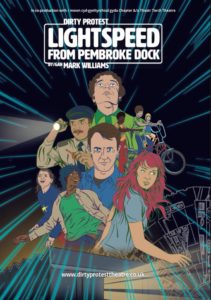
Dirty Protest blasts off into 2018 with launch of project inspired by Wales’s claim to Star Wars fame.
“Lightspeed from Pembroke Dock, a co-production between Wales’s acclaimed new writing company, Dirty Protest, Chapter and the Torch Theatre, takes the 1979 Pembroke Dock building of the full-scale Millennium Falcon as its inspiration

The Millennium Falcon under construction in Pembroke Dock
The drama written by playwright Mark Williams and directed by Julia Thomas is inspired by the real-life construction in Pembroke Dock shipyard of the full-size Millennium Falcon spaceship, helmed by Harrison Ford’s Han Solo in the film ‘Star Wars: The Empire Strikes Back’.
Set in Pembroke Dock in 1979 and 2014, our hero Sam is a Star Wars obsessed kid in 1979 and a single father in 2014. His father is a redundant shipwright, employed to build the Millennium Falcon. Incredibly, far from being from a long time ago in a galaxy far, far away; the ship featured in the second film in the Star Wars saga was constructed by a small army of tradesmen in the Pembrokeshire town’s Western Hangar. All were sworn to secrecy as the ship came together far from prying eyes. Now, Dirty Protest brings the story to the stage in a production that combines the thrill of 1980’s adventure movies with an intergenerational family saga all of its own.”
We caught up with Catherine Paskell, Artistic Director of Dirty Protest Theatre Company and playwright Mark Williams to discuss this exciting new project.

Playwright Mark Williams
Hi Mark great to meet you, so what got you interested in writing?
I’ve always loved stories, and was a big reader of books and comics from an early age. I had a great teacher in primary school, who encouraged me to let my imagination run wild in creative writing lessons. I remember vividly the moment when I realised that in a story, you could transform the world, in any way you wanted to. As I got a bit older, I became interested in the ‘behind the scenes’ world of TV and film. Magazines and movie tie-in books often had interviews with writers, and that opened up the idea that writing was a process, and something it was possible to do as a career.

Catherine Paskell Artistic Director of Dirty Protest.
Thanks Mark, Catherine can you please tell us more about your role?
I’m Catherine and I’m the Artistic Director of new writing company Dirty Protest. I have recently directed Sugarbaby by Alan Harris which Dirty Protest took to Paines Plough’s Roundabout Summerhall venue with Wales in Edinburgh last summer. I was a founding creative associate of National Theatre Wales – it was this opportunity that brought me back to Wales. I love what I do and connecting to people with theatre making in Wales.

Mark you are a playwright can you explain how this role operates within the creative team on a theatrical production ?
So far, every production has followed a slightly different model. Sometimes my role has more or less ended when rehearsals began. Other times, I’ve been more actively involved, right up until the show opens, and during the run. There can be lots of factors determining the writer’s role, ranging from how the director likes to work, to the needs of the producing company, or your own time commitments on other projects. Ideally, I love it when the process is as collaborative as possible.
As a playwright you reference and are inspired by a range of elements of popular culture, why do you think this is?

George Lucas on the set of Star Wars with Mark Hamill (Luke Sywalker)
Many of the artists and writers that inspire me have always been proud of the eclectic mix of pop culture that informs their work – Ray Bradbury, Michael Chabon, Neil Gaiman, Russell T Davies, and, especially in relation to this new production Lightspeed, Steven Spielberg and George Lucas. Pop culture is what first inspired me to write, and continues to do so. I think negative value judgements are sometimes made on aspects of it (perhaps less so these days, now it’s all-pervasive!) But as well as being entertaining, I love the fact that you can stumble on depth and substance in unexpected places, if you keep an open mind and a curious eye.
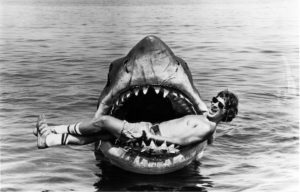
Steven Spielberg on the set of Jaws
And to continue the query above is this something you consider when thinking about developing audiences for your work?
Yes, always. When it comes to audiences for your own work, you start to think about what you can bring to the table yourself. How that can inform your own characters and stories, and connect with an audience’s own experiences.

Catherine I wonder if you could reflect on Dirty Protests’s journey from script in hand performances in the yurt in Milgi’s to this new production?
It’s been 10 years getting us to this point! We’ve staged plays in tents, fields, kebab shops, hairdressers, basement dives, attack bars and even theatres. Dirty Protest started in August 2007, with crowds of people crammed into the yurt in Milgi’s backyard, craning their necks to see the performers, reading from scripts-in-hands, stood amongst the beds and sofa cushions.

Script in hand event at Milgis
It was a must-be-there new writing event, and ever since then Dirty Protest have spent the last decade at the head of a revolution in Welsh new writing, building a community and being a place for theatre makers to belong. Now we work across Wales, with fantastic Welsh co-producers, theatres and venues. We have worked with over 250 writers and collaborated with fantastic partners outside Wales, including legends like the Royal Court, the Almeida, Paines Plough, Traverse Edinburgh, and Latitude. We have kept the same ethos and ambition to nurture a community, and forge new spaces and higher profile platforms for exceptional Welsh new writing to be performed in and out of Wales. We have always kept ourselves busy but so far, our 10th year anniversary is our busiest time yet! We have performed at least one event each month since our celebrations began in August. As I mentioned earlier we took Sugar Baby by Alan Harris to the Edinburgh Fringe Festival as part of Paines Plough’s Roundabout programme. The show was well received, we were 1 of only 8 shows added to the British Council Showcase, alongside Soho Theatre, The Bush Theatre, Tobacco Factory and National Theatre of Scotland. We were so chuffed with that! But not content to just take one show to the Fringe, we also staged 5 additional new short plays by 5 Welsh writers at the Fringe to show international audiences just how fantastic our new writing talent is in Wales.

Production image ‘It’s The End Of The World As We Know It (And I Feel Fine)’ with Volcano.
Back home in September and October, we then created our Welsh language short play event Protest Fudur with our partners Galeri in Caernarfon, and staged more short play events with Wales Millennium Centre and Fuel, staged a 10-year take over of The Other Room, and celebrated that It’s The End Of The World As We Know It (And I Feel Fine) with Volcano for their Novemberfest in Swansea. This December, over 4 days we are staging a development production of a brand new Christmas monolougue, Cut and Run by Branwen Davies with the incredible performer Catrin Stewart who will bring the story to life in the most beautiful way. This development Christmas monologue follows in the steps of our previous annual anti-panto Christmas shows, including the hugely popular Last Christmas by Matthew Bulgo (which was The Traverse Theatre, Edinburgh’s studio Christmas show last year).
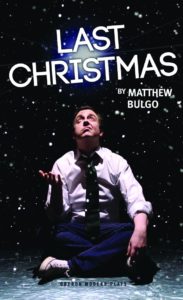
All that, and we are only 5 months into our anniversary year! So then we will deserve a Christmas breather before January kicks off with us producing a Contemporary Theatre Festival with the University of South Wales, before we travel across Wales trying to meet as many writers and actors and directors as possible. We will be developing writers and new plays with venues across Wales in the lead up to the Lightspeed From Pembroke Dock tour.
I can’t wait for the culmination of the tour: a Star Wars-inspired arts festival in Pembroke Dock, called the May the Fourth (be with you) festival happening on – yes, you’ve guessed it! – Saturday 4th May.
There’s still lots more planned that we can’t announce yet and loads more ways that people can get involved. Our 10 year anniversary isn’t just about what’s passed – it’s about what’s yet to come. I really hope that people will come and be part of Dirty Protest all across Wales and help us create the theatre of the future.
Mark, what do Dirty Protest mean to you as Welsh playwright?
Firstly, via their short play nights and events, they provide a brilliant opportunity for new and emerging writers to get their work read by actors in front of an audience, and for more established writers to try out new ideas, and have fun in a relaxed environment. Secondly, they’re fast becoming a leading producer of new writing in Wales, helping writers to get their work made, toured, and seen further afield. Their commitment and enthusiasm to actively developing both of these strands is a vital part of the arts in Wales.
Catherine this will be Dirty Protest’s third fully staged drama? is this correct? With your biggest tour to date, what does this mean for the company?
Lightspeed From Pembroke Dock is actually Dirty Protest’s sixth fully staged drama since 2007, on top of numerous development productions and short play events which bridge the gap between rehearsed readings and full-scale productions.
This production is hugely exciting for us because we can join the Rebel Alliance of Welsh theatre! It’s our chance to tell a story that is uniquely Welsh, connected to the people and society of Pembroke Dock, but also places Wales at the heart of one of the world’s biggest film franchises. It’s our first show that is specifically created for audiences of all ages. If you’re old enough to see a Star Wars film, you’re old enough to see Lightspeed From Pembroke Dock!
We are excited to be working with two collaborators – writer Mark Williams and director Julia Thomas – who have been with Dirty Protest since the early years, working with us on numerous short play events over the last 10 years. It’s fantastic that they will be making a fully staged production together with us and explore a new area of theatre making for Dirty Protest, as they are both experienced in making theatre for all the family. Julia is currently directing Leicester Curve’s Christmas Show, George’s Marvellous Medicine and I remember seeing a stage show of Horrible Science that Mark had written, where I had to wear 3D glasses so digital poo could fly out of a toilet into my face!
We can’t wait to take Lightspeed From Pembroke Dock on tour all across Wales and to meet new audiences who won’t have ever seen Dirty Protest before. We will be returning to some venues where we have performed previous hit plays like Last Christmas by Matthew Bulgo and Parallel Lines by Katherine Chandler, or staged our short play nights.

Parallel Lines
We are also going to new venues who we’ve wanted to visit for years, and now we can! I really hope that people who already know us, and people who we have yet to meet, will come and join us as we blast across the nation on our newest adventure.
Thanks you both and finally do you have a favourite character from the Star Wars movies and why?
Mark Han Solo. Who wouldn’t want to fly the Millennium Falcon?
Catherine Lando Calrissian from Episodes V and VI. He’s funny, and dramatically interesting and complex: he’s a kinda bad guy – he’s a gambler who loses his ship the Millennium Falcon to his friend Han Solo, and he also tricks his friends so they get captured by Darth Vader. But he then has a turn of conscience, helps his friends escape and joins the Rebel Alliance! So he turns into a good guy! He’s the epitome of what Star Wars is about, to me – growing up, surviving the galaxy, and being there for your friends.
Thank you both for your time
The production tour dates can be found below
Tour Dates:
Wed 4- Sat 7 April
Chapter, Cardiff
Tue 17 April
Soar Centre, Valleys Kids
Wed 18 April
Ffwrnes, Llanelli
Thu 19 April
Taliesin Arts Centre
Fri 21 April
Riverfront, Newport
Mon 23 April
Halliwell Theatre, Carmarthen
Tues 24 April
Pontardawe Arts Centre
Wed 25 April
Borough Theatre, Abergavenny
Thurs 26 April
Blackwood Miners Institute
Fri 27 April
Galeri, Caernarfon
Sat 28 May
Aberystwyth Arts Centre
Wed 2 May
Theatr Brycheiniog, Brecon
Fri 4 – Sat 5 May
Torch Theatre, Milford Haven
Review Justice League by Jonathan Evans

 (2 / 5)
(2 / 5)
And so, seeing the unquestionable success that MARVEL has been having with their shared cinematic universe DC have stumbled greatly to get to this point. But nothing was gonna stop this cinematic train so, we just have to deal with it.
What brings our different heroes together are three boxes called “Mother Boxes” if all three are brought together they’ll destroy the world (basically). The one that is out to get all these Mother Boxes is a giant being named Steppenwolf (Ciaran Hinds), he’s about ten feet high, clad in Armour, wields a large axe and spouts over-the-top dialogue. His role is similar to Loki in Avengers (even to the point of wearing over extravagant headgear) but he lacks Hiddelston’s charisma as well as fails to convey a real threat. He’s just a big threat that is no more interesting or memorable that a generic video game boss.
The first members that have already been established are Batman (Ben Affleck) the dark brooder that is just a skilled human with great technical resources and detective skills. Wonder Woman (Gal Gadot), she was the best thing in Batman v Superman and her own movie was the best of these movies but also rather good. The same present here. The Flash, the speedster played by Ezra Miller. He is here to portray the every-man, being more trepidatious and a lot more dumbfounded when giant man and bug creatures appear. But he says some things that are just odd, it is a weird thing that writers do where they put in quirks and think they’ve made a character, they haven’t, he gets better as the movie goes on but when he starts he might be an alien on Earth. Next is Aquaman (Jason Mamoa), he can breathe underwater, is very strong and wields a large five pronged spear (not a trident), he will probably be the breakout character, being a swaggering brawler. Finally is Cyborg (Ray Fisher), originally a young student named Victor Stone has now been transformed by the Mother Box technology and is fused with it.
Probably the worst kept secret and obvious plot point that any five year old could see coming is that Superman (Henry Cavil) returns (he died in the last movie). He does and he is much better here than in the previous two movies, he knows what smiling is, I believe he’s an optimistic person and they gave colour back to his costume instead of a grey filter.
Due to a family tragedy Snyder had to pull out of the movie. Most of it was completed but still needed finishing. Director Joss Whedon stepped in and completed the project. There is only so much one can really affect a movie when probably over seventy five percent of it has been completed. Whether it be due to fan outcry or Whedon inserting it in where he could there are much more smiles in this movie. Characters are smiling and aren’t brooding constantly. Having one moody one on a team is fine (that’s what Batman’s there for) but the others need to bring a balance of different types of characteristics.
Also more present in the movie is colour. They still use heavy amounts of black but they are contrasted with deeper, vivid colours of red, golds etc. This is a better direction to go, it keeps the colour but visually distinguishes it from the MARVEL movies.
Probably the biggest failure of the movie is the score by Danny Elfman. Not at any point did I feel my spirits roused by the music and I cannot hum any of the score. It is unfortunately forgettable and not moving.
Unlike all the other movies this one does have a post credits scene. So if you are so inclined stick around and you wont just see the credits scroll by.
So it has indeed been a very bumpy ride. It did not get off to a good start at all and from there on it got worse. But now the pieces have come together and the final result probably wasn’t worth it but it also wasn’t a complete disaster. It was actually rather serviceable.

Jonathan Evans
An interview with Jorge Lizalde

The director of Get the Chance, Guy O’Donnell recently met with Photographer/Videographer/ AV designer and Projection Mapper Jorge Lizalde. They discussed his training in Spain, his most recent work with Lucid Theatre Company on Little Wolf and his thoughts on the arts in Wales.
Hi Jorge, great to meet you can you give our readers some background information on yourself please?
Hi, I am Spanish and was born in Zaragoza and moved 12 years ago to the UK when I finished my art studies in Salamanca and then Madrid. When I arrived in the UK I worked for four years as a cinema projectionist at Vue Cinemas at the Angel (London) as well as The French Institute (London) where the projection is still old school, swapping film reels every hour over two projectors, a job that I loved but digital cinema has killed it. In 2009 I moved to Cardiff and since then I have been freelancing as Photographer/Videographer and most recently as an AV designer and Projection Mapper.
So what got you interested in the arts?
My grandfather Jose Luis Cano (on my mother’s side) was a famous watercolour painter from where I come from, his son, Jose Luis Cano (both my grand father and uncle, share the same name as it’s a Spanish tradition to name your son after your father.) my uncle, is a well known painter/illustrator, he creates the satiric daily drawings on the local newspaper, Heraldo De Aragon. My grandfather had an art studio, known as Studio Cano that’s why I trade commercially with that name, which is my second surname, in Spain we keep both surnames from the father and the mothers side. The different people I encountered at Studio Cano learned different painting styles and disciplines at the studio. I spent a lot of my childhood and teenage years there, painting, drawing, etc. It is where I got ready for my University access as in Spain to study a BA in Fine Arts you need to know how to draw a life model as part of your A Levels. At Uni I learned many different disciplines of painting, sculpture and drawing as studies are quiet traditional, making my own canvas, paints, etc. My father was into photography just as an amateur but his brother was a commercial photographer. I didn’t really got interested in photography until my father passed away 18 years ago and I was passed down his heritage and his equipment at the end of my first year at Uni. In addition, many friends of my parents are ceramists, architects, etc. Art was always around, so I guess it was inevitable that my brother (classical/flamenco guitarist) and myself would finally become involved in the arts as a career.

Jorge Lizalde, “Mnemonic” at G39 gallery
You have a wide variety of film and photographic skills. When you are photographing a theatrical production how do you approach the process of taking an image?
With every shot I treat it as individual, my camera settings and focus are manually set so I have total control of the shot. Having started as self-taught on film, before digital photography took over, has helped me to have a good understanding of the tech, so I just have to pay attention to what’s going on in front of me (actor interactions, movements, reactions, expressions etc.) I don’t like to retouch pictures afterwards in post-production, I just readjust the white-balance that sometimes the camera can get wrong. Foe example theatre lights can have new LEDs which can be can be really tricky on temperature and contrast, but what you see on the picture is normally what I initially capture. What I do particularly like is to move around a lot as this gives me some perspective and creates more interesting shots that just an on the spot view from the auditorium. From a dress rehearsal session I can get around 150 usable shots, its then the job of the producer or the person in charge of marketing to choose the final images.
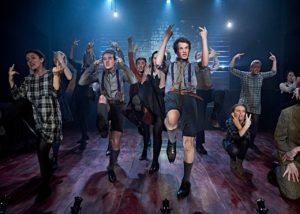
Credit: Gamta School by Jorge Lizalde | studiocano.co.uk
What makes a good image for a theatre production?
A well composed and focused picture of a scenario or situation that through the actors expressions tells you exactly what’s going on. If on top of that it gives you a sense of the stage or space that to me is a hell of a picture.

Credit: Roberto Zucco – August 012 by Jorge Lizalde | studiocano.co.uk
You also design and map Audio Visual projection for live performance, with new technologies this is a rapidly developing area, how do you see this art form developing?
Mapping projection is not new and has been part of theatre or arts for many years. Recently The Far Side Of The Moon by Robert Lepage was performed in Cardiff at The Wales Millennium Centre
LePage is known for some great experimentation and mapping projections, that production is 17 years, believe it or not! What it is really developing fast it is the technology is becoming faster and cheaper. What a projector could give you 10 years ago in terms of quality for £25,000 you can have it now for just £1,400 and in a 1/5 of the size too. It’s the same with computers, they are faster to process the video codecs, I can edit and program a video on the middle of the tech session if needed, something unthinkable a couple of years ago, so AV is no longer part of a privileged group with lots of money it can be also part of small budget productions or projects.
Untitled.mp4Credit: Clockwork Orange / Curve Theatre – AV Mapping by Jorge Lizalde | studiocano.co.uk
Continuing this theme of embracing new technologies you also utilise drone camera footage in your work, most recently in “Little Wolf” by Lucid Theatre Company. Can you tell us how you have developed your skills in this area and again how you see this art form developing in the future?
I bought my drone this summer for my own project about Brexit and what it means to be an EU citizen today in the UK, as at the moment I feel we don’t belong to any land. The model I bought has some great features as well as a quality image, you can control it with the hand. I took it this summer to Finland where I was part of Oulu Hack Week organised by Taikabox, three days of experimenting with new technologies and dance where we tested it and created a little presentation or dance piece with it.
Now I am developing and experimenting a bit more with its possibilities and limits for the stage. I will have a hack day with Lara Ward at the end of November and hopefully refine its use in the future to create a little performance with it . Since I bought it I haven’t stoped using it, for example as you mention with Little Wolf where I created some footage overlooking water, – a swimming pool, a lake and the sea, it was really helpful. It’s still early days to say where this tech will go but it has become cheap and really fast so I wouldn’t be surprised if everyone owns one, even if it is just for selfies which it is what my little drone was designed for in the first place!

Credit: Little Wolf / Lucid – Av mapping by Jorge Lizalde | studiocano.co.uk
Get the Chance works to support a diverse range of members of the public to access cultural provision Are you aware of any barriers to equality and diversity for either Welsh or Wales based artists/creatives?
Yes I am really aware, I am Spanish and have an accent that in many cases is judged as not educated or a knowledgeable person. I haven’t been able to get some jobs because of it. At the beginning it was annoying when people tried to maximise their mouth motion and slow their pronunciation when talking to me because they think I didn’t understand but now I just do the same to them if they do, I slow my talking and maximise my pronunciation, maybe that’s why I don’t get the jobs but who wants to work with someone that diminishes you by your accent? Also, I have been involved with Taking Flight Theatre Company
As well as other theatre companies developing live subtitles, I have been working on creating theatre which is more accessible to all audiences. I believe I am the only person in the UK using the software I am working with, or at least this is what a programmer recently told me! It is software created for film cinema subtitles but I adapted to theatre. It can be projected over projections, it can be programmed to be part of the stage and interact with actors, it can be shared in any device, Android or Apple, phone or pads and via a local network which can be used in a promenade performance without access to the internet. In addition I am developing live speech to text subtitles (same language or a live translation of it as for example Welsh-English or Spanish- English) but the technology is not there yet, hopefully with the development of home assistants like Google Home and Amazon Alexa the interpretation of the language will get faster and better.
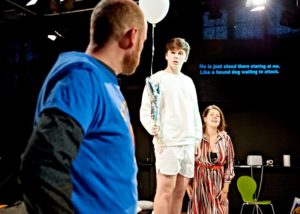
Credit: Yuri / August 012 | Subtitles and picture by Jorge Lizalde | studiocano.co.uk
There are a range of organisations supporting Welsh and Wales based artists and creatives, I wonder if you feel the current support network and career opportunities feel ‘healthy’ to you?
I think it is pretty healthy, a bit more funding would be great, especially after so many years of having cuts in the arts budgets. The only problem I am facing this days is, I am in my late 30s so there are no prizes or opportunities for that age or not as many, most are focused on early career or under 30s. If you are a mid 30s or early 40s creative and want to start an art career there are not many opportunities to build a good portfolio and be quickly part of the art community.

Credit: Own Installation, “Editing my father” at Ffotogallery
If you were able to fund an area of the arts in Wales what would this be and why?
To choose an specific area would be to discriminate against the others. I never understood targeting specific areas, all areas, race, social, cultural backgrounds, etc should be considered every year for equally and fund them according to the excellence of the projects and their outcomes. If that means some stablished organisations loose funding after many years receiving it because independent or small projects are creating better projects to present, so be it.

Credit: “Cymru & I” Collaboration with Japanese choreographer Yo Nakamura
More information about the project linked to the above image: http://jorgelizalde.com/iframe-2/iframe/index.html
What excites you about the arts in Wales?
What really excites me it is the size of the art community, it is not big, so you soon know most of the artists working in Wales. This also makes it really accessible, and that gives you great freedom to experiment and collaborate with other artists and start new projects or enterprises. It creates opportunities for pop up exhibitions, zines, performances, etc. I don’t think there are enough links with work which is part of a performance or the theatre/artistic community with visual or more modern arts groups but hopefully in the future there will be more collaborative work between art galleries – g39, Ffotogallery and Chapter – with the performance festivals – Festival of Voice, Cardiff Dance Festival – or venues like the WMC or Chapter – as well as artists from both backgrounds. When they have collaborated in the past at events such as Experimentica or Artes Mundi there are more interesting projects happening and everybody really gains from it, creatively and culturally.

Artes Mundi 2017 Winner John Akomfrah with artwork Auto Da Fé © Polly Thomas

Credit: “1865” prototype game app in collaboration with Yellobrick, Nesta and National Library of Wales
Link to more information on the project above https://www.nesta.org.uk/our-projects/digital-rd-fund-arts-wales-case-studies/arts-archives-and-technology
What was the last really great thing that you experienced that you would like to share with our readers?
I have always been interested on working with lights and mapping lights structures these are getting more and more interesting, especially with LEDs stripes, with them you can have as many different colours and sync as you like. A good example of it is Robert Hencke’s Lumiere III laser lights installation which I saw at the Barbican main theatre at the beginning of this year and it was one of the greatest art experiences I have ever seen.
Thanks for your time Jorge.
You can find more information about Jorge and his work at the links below.
Personal
Commercial
Review Professor Marston & The Wonder Women by Jonathan Evans
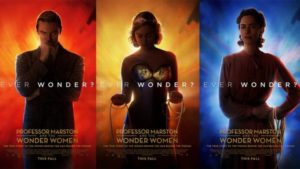
 (4 / 5)
(4 / 5)
She is one of the most iconic female characters in pop culture. She is instantly recognisable and you most likely know her name. She stands for truth. But in creating her secrets had to be kept to preserve love.
Earlier this year the mass audience were introduced to Wonder Woman through her first film. Now she is more popular than ever, this is the perfect time to tell this fascinating story of the deep psychological ideas that went into her creation and first few stories as well as the just as interesting behind the scenes situation of the people that inspired her.
The man who co-created her was man named William Moulton Marston (Luke Evans), a university professor who teaches psychology. He would go on to invent the lie detector machine. While there with his wife one of his students catches his eye. His classes teach about the mindset of giving yourself up to an authority figure in a relationship.
Elizabeth (Rebecca Hall) is his official wife whom he has known since childhood, she has dark hair and is more than qualified to be a lecturer at any University, but because she is a woman she cannot gain any diploma. Her and Marston enjoy heated debates. Olive (Bella Heathcote) is blonde, a few years younger and even though she is descended from two of the most outspoken and radical feminist of her time was raised by nuns so is timid and tacked but still very intelligent.
He loves his wife, however he also loves Olive and they love him as well as each-other. What are they to do? The love is real but the society in-which they live will never accept them, is it even worth trying?
Luke Evans himself is a gay man and the writer/director Angela Robinson is a lesbian. They are both open about their sexuality but the world still does not fully embrace people of non hetero sexuality so they are probably the perfect people to tackle this material.
Adding to the revealing nature of the movie is the layering of the actual Wonder Woman comics that were written by Marston and indeed do feature Wonder Woman herself and other women caged, tied-up, spanked etc. The fact that they were able to get approval for the actual material shows and bravery and how unashamed on behalf of DC Comics. This is the story and ideas that went into the character and are addressing it.
The theory of loving submission isn’t just all about getting tied-up and/or spanked (though the physical acts are a part of it) it is about letting go of control, it has been said that you cannot love someone and control them, the acts allow the others to be the master to ones who would otherwise not be.
Being that this takes a look behind the public perception of a famous character and shows the story of the real people behind the scenes one will probably be reminded of Hollywoodland (an equally good movie).
This movie tells the story of love that is still rather unconventional now and seemingly impossible at the time it happened. There are details about the production of the character of Wonder Woman that are skimmed over as well as a few other moments that take a leap in time in order to fit the correct running time. But the story it tells is one of love and understanding and it effectively conveys that message.

Jonathan Evans
